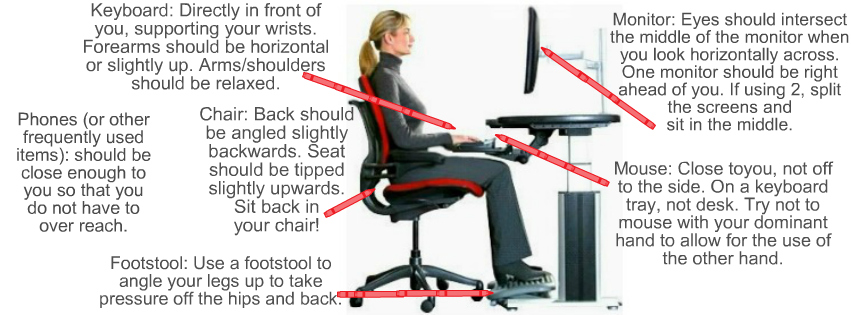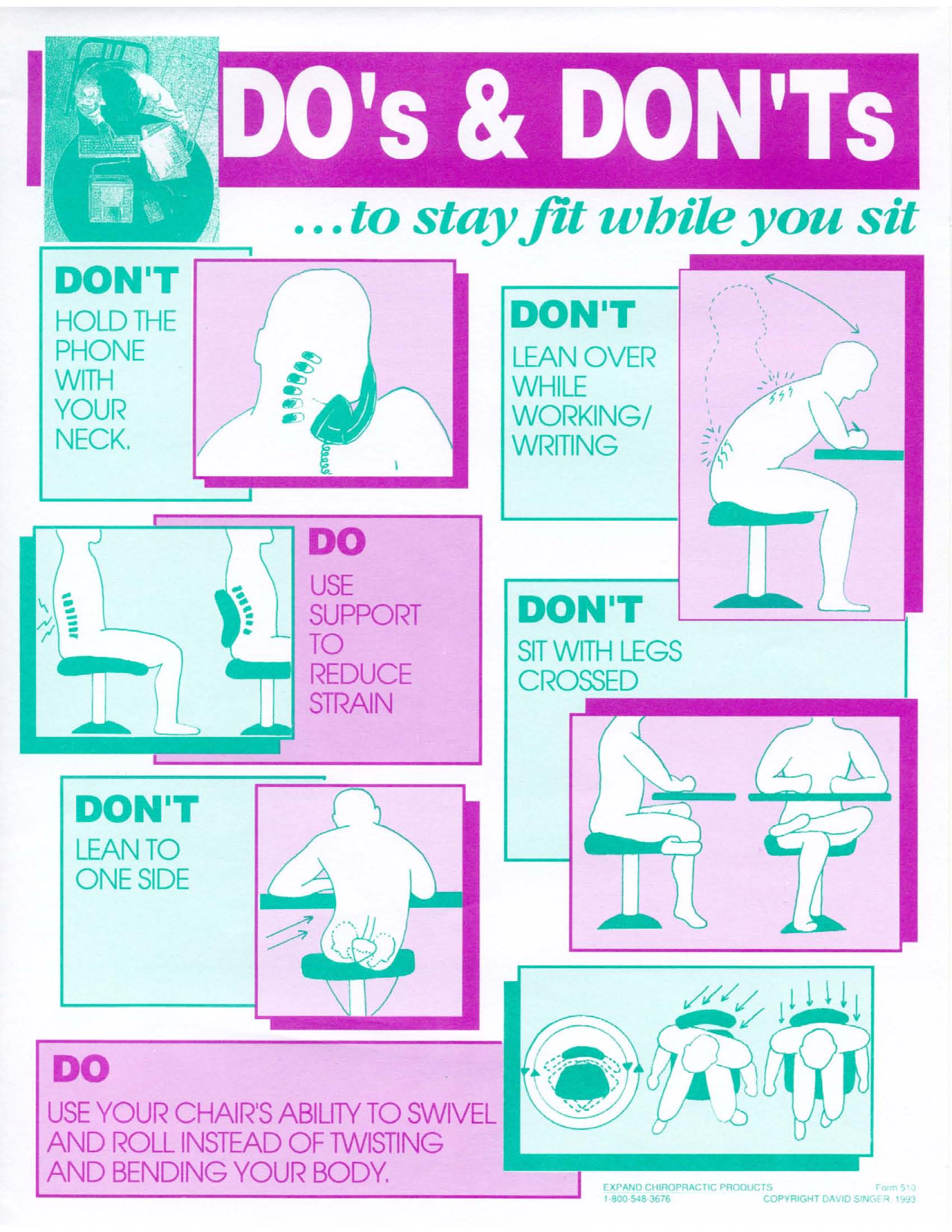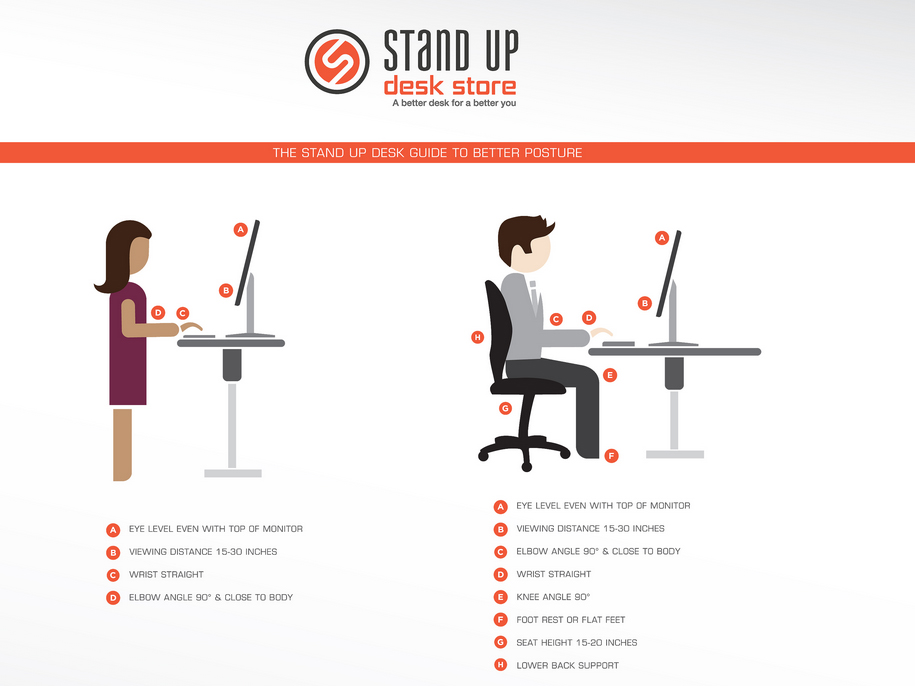How Prolonged Sitting Can Affect Your Health
by Dr. Barbara Rodwin
Workstation ergonomics explained! We as human beings are not designed to spend hours hunched up in a chair, looking at screens on a fixed focal plane and talking on the phone. By reducing “Excessive Sitting” to less than three hours a day, our life expectancy can increase by two years, according to a 2012 study! If we sit in for long periods of time this slows our blood flow, tightens muscles, causes joint restrictions, makes us tired due to lack of oxygen and many other things! Try to avoid sitting for longer than 45-60 minutes at a time. Several hints to ensuring you stand up are the following: Set a reminder in your scheduler (the one that pops up to remind you of meetings) to remind you to stand up! You do not necessarily have to walk any place, just stand move your body around and then sit back down. If you cannot schedule the stand break this way then use a kitchen timer and set it to go off periodically. As well think of either purchasing a sit/stand station so that you can alternate positions or make your own! Ask Dr. Barbara Rodwin how to make your own.
How to Work on Your Posture
by Dr. Barbara Rodwin
Often I have to speak to patients about their sitting habits. We think that the sitting is not the best for us but indeed part of the issue is the way in which we sit and use our workstation. I will outline the proper workstation set-up. You can also find a video we just produced below that will show you all of this.
Chair: Take the back of the chair and angle it slightly backwards and the seat angle it slightly upwards. You will now be reclining slightly. When we sit in this position it takes a lot of pressure or force off our legs, hips and lower back. Also ensure you have the back of the chair raised as high as it goes (there is a dial on the back of the chair for this).
Monitor: Your eyes should when looking horizontally across intersect the middle of the monitor. Have it right in front of you and if using 2 monitors split them in front of you.
Footstool: Place your feet on this as this takes pressure off your hips and lower back!
Keyboard and mouse: When your arms and hands are on these they should either be at a 90 degree angle or slightly up. Ensure when they are placed on these that there is not tension in the shoulders. If there is either use armrests or change the position of the arms. I often tell patients to mouse with their non-dominant hand as we do so many other tasks with this arm.

When We Sit:
1. Calorie burning slows to 1 calorie per minute.
2. Enzymes in the blood that burn fat drop 90%.
3. After 2 hours of sitting, good cholesterol levels can drop 20%
4. The electrical activity in the legs and gluteal muscles slows way down.
___
Effects of Prolonged Sitting on Joints and Muscles
Posture problems such as strained neck and shoulders: It’s common to hold your neck and head forward while working at a computer or cradling a phone to your ear. This can lead to strains to your cervical vertebrae along with permanent imbalances, which can lead to neck strain, sore shoulders and back.
Back Problems: Sitting puts more pressure on your spine than standing, and the toll on your back health is even worse ifyou’re sitting hunched in front of a computer. It’s estimated that 40 percent of people with back pain have spent long hours at their computer each day. The disks in your back are meant to expand and contract as you move, which allows them to absorb blood and nutrients. When you sit, the disks are compressed and can lose flexibility over time. Sitting excessively can also increase your risk of herniated disks.
Muscle Degeneration: Standing requires you to tense your abdominal muscles, which go unused when you sit, ultimately leading to weak abdominals.
Hip Problems: Your hips also suffer from prolonged sitting, becoming tight and limited in range of motion because they are rarely extended. In the elderly, decreased hip mobility is a leading cause of falls.
Sitting can also weaken your gluteals, affecting your stability and the power of your stride when walking and jumping.
Sit Less, Stand More. Start Now!
1. Walk across the hall to talk to a coworker instead of sending an email
2. Take the stairs instead of the elevator
3. Park your car further away from the entrance
4. Take a longer, roundabout way to your desk
5. Set a timer to remind you to stand up and move about for at least 10 minutes each hour.
6. Use a sit/stand workstation






